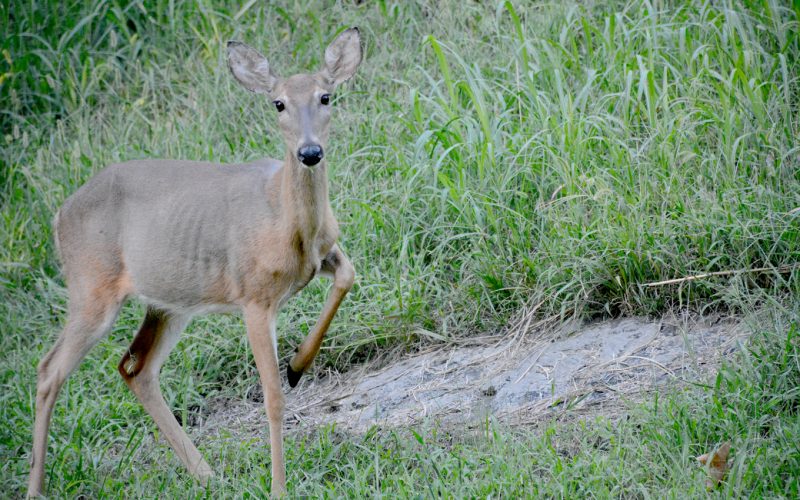
Staff Photo Amanda Bancroft: A whitetail deer spotted outside Amanda Bancroft’s home in Fayetteville.
There are at least fifty species of deer found throughout the world, including elk, caribou, and our familiar white-tailed deer. The South American pudu only weighs seventeen pounds, while a male moose can weigh up to two thousand pounds. The white-tailed deer comes in at between one hundred twenty-five to three hundred pounds. Despite seeming taller with antlers, white-tailed deer are roughly three and a half feet tall.
Even if we think we know everything about our nibbling neighbors (except how to keep them out of the vegetable garden) deer can be quite surprising. They are ungulates, or “hoofed animals,” a group of large mammals that includes camels, horses, cattle, pigs, giraffes, and surprisingly, hippopotamuses, whales and dolphins, too! Those last three aren’t commonly referred to as ungulates because despite shared ancestry, they lack the common morphology of other ungulates like deer.
White-tailed deer can actually see in color, but not like humans do. Our eyes enable us to see more of the red spectrum, while a deer is designed to notice mostly blues and greens. The color “safety orange,” worn by hunters, doesn’t stand out much to a deer! But of course they are extremely good at detecting motion and leaping away from us, flicking their snow white feather dusters as a warning signal to other deer.
The age of a deer is difficult to determine at a glance, and counting antler tines is not reliable. This is because a hard year may make an older deer appear much less developed, with smaller antlers, while a good year with excellent nutrition can enable bucks to have larger antlers than is typical for their age. Males of the white-tailed species, along with most deer species in North and South America, are called bucks and the females are referred to as does. But moose and elk are called bulls (males) and cows (females). Red deer, sika deer, and some other Old World species are called stags (males) and hinds (females).
We’re entering the rutting season, when deer mate in October and November so that females give birth around May and June. Twins aren’t all that uncommon, with female white-tailed deer producing two to four fawns per year, allowing her to give birth up to thirty times during an average lifetime!
The book White-tailed Deer by Mark Raycroft contains gorgeous photos revealing the hidden lives of these animals, as well as a chapter on photographing deer for those who want to venture afield during hunting season for a different kind of shot. Deer are skittish and their senses are highly adapted to detect possible threats, so it can take a lot of time to learn their routes and catch them unawares. With experience, though, communing with deer can be a part of our daily routine, bringing us closer to the wild right within our own neighborhoods.
Ripples is an emerging online educational center inspired by a holistic approach to making a difference. Follow our journey to live sustainably and make ripples with our lifestyle at: www.RipplesBlog.org.










